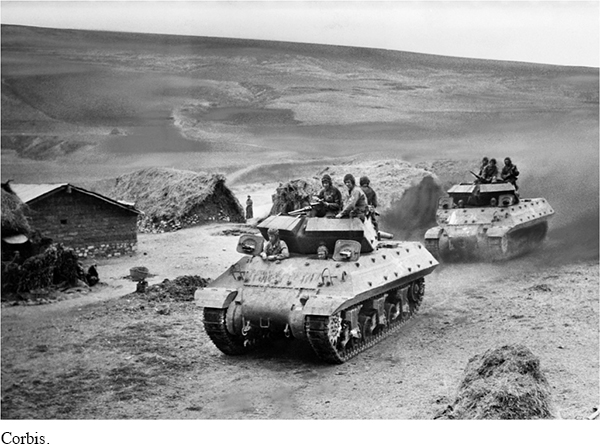The Campaign in Europe
After Pearl Harbor, Hitler’s eastern-front armies marched ever deeper into the Soviet Union while his western-front forces prepared to invade Britain. As in World War I, the Germans attempted to starve the British into submission by destroying their seaborne lifeline. In 1941 and 1942, they sank Allied ships faster than new ones could be built. Overall, the U-boat campaign sank 4,700 merchant vessels and almost 200 warships and killed 40,000 Allied seamen.
Until mid-1943, the outcome of the war in the Atlantic remained in doubt. Then, newly invented radar detectors and production of sufficient destroyer escorts for merchant vessels allowed the Allies to prey upon the lurking U-boats. After suffering a 75 percent casualty rate among U-boat crews, Hitler withdrew German submarines from the North Atlantic in late May 1943, allowing thousands of American supply ships to cross the Atlantic unimpeded. Winning the Battle of the Atlantic allowed the United States to continue to supply its British and Soviet allies for the duration of the war and to reduce the imminent threat of a German invasion of Britain.
> UNDERSTAND
POINTS OF VIEW
How did Stalin’s strategy for the Allies’ fight against the Nazis differ from Churchill and Roosevelt’s plan?
The most important strategic questions confronting the United States and its allies were when and where to open a second front against the Nazis. Stalin demanded that America and Britain mount an immediate and massive assault across the English Channel into western France to force Hitler to divert his armies from the eastern front and relieve the pressure on the Soviet Union. Churchill and Roosevelt instead delayed opening a second front, allowing the Germans and the Soviets to slug it out. This drawn-out conflict weakened both the Nazis and the Communists and made an eventual Allied attack on western France more likely to succeed. Churchill and Roosevelt decided to strike first in North Africa to help secure Allied control of the Mediterranean.
In October and November 1942, British forces at El-Alamein in Egypt halted German general Erwin Rommel’s drive to capture the Suez Canal, Britain’s lifeline to the oil of the Middle East and to British colonies in India and South Asia (see Map 25.4). In November, an American army under General Dwight D. Eisenhower landed far to the west, in French Morocco. Propelled by American tank units commanded by General George Patton, the Allied armies defeated the Germans in North Africa in May 1943. The North African campaign pushed the Germans out of Africa, made the Mediterranean safe for Allied shipping, and opened the door for an Allied invasion of Italy.[[LP Photo: P25.07 North African Campaign/

In January 1943, while the North African campaign was still under way, Roosevelt and Churchill met in Casablanca and announced that they would accept nothing less than the “unconditional surrender” of the Axis powers, ruling out peace negotiations. They concluded that they should capitalize on their success in North Africa and strike against Italy, consigning the Soviet Union to continue to bear the brunt of the Nazi war machine.
In July 1943, American and British forces landed in Sicily. Soon afterward, Mussolini was deposed in Italy, ending the reign of Italian fascism. Quickly, the Allies invaded the mainland, and the Italian government surrendered unconditionally. The Germans responded by rushing reinforcements to Italy, turning the Allies’ Italian campaign into a series of battles to liberate Italy from German occupation.
> COMPARE AND CONTRAST
How did U.S. military campaigns in Europe differ from those in the Pacific? What experiences did combatants in the two theaters of war have in common?
German troops dug into strong fortifications and fought to defend every inch of Italy’s rugged terrain. Allied forces continued to battle against stubborn German defenses for the remainder of the war, making the Italian campaign the war’s deadliest for American infantrymen. One soldier wrote that his buddies “died like butchered swine.”
> QUICK REVIEW
How did the United States seek to counter the Japanese in the Pacific and the Germans in Europe?
Understanding the American Promise 3ePrinted Page 723
Section Chronology